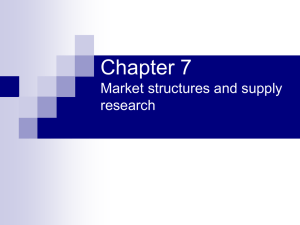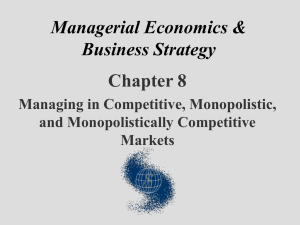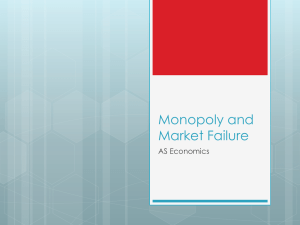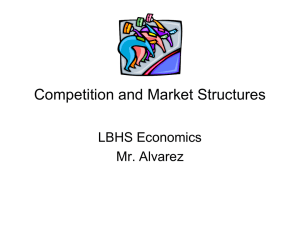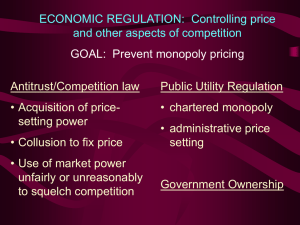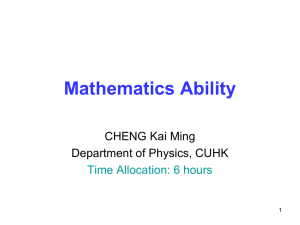π 1
advertisement
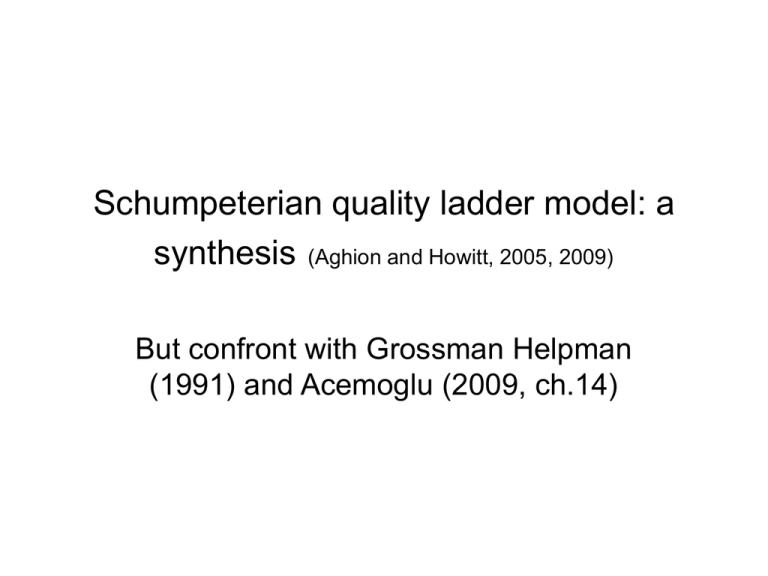
Schumpeterian quality ladder model: a
synthesis (Aghion and Howitt, 2005, 2009)
But confront with Grossman Helpman
(1991) and Acemoglu (2009, ch.14)
technology
Y
t
m
0
it
it
A x
L
i
m
1
1
Instantaneous production
•
•
•
•
•
A continuum [0, m] of intermediate goods varieties
1 unit of x produced with 1 unit of Y
Elasticity of substit. between varieties: 1/(1 )
Y sector is competitive:
input price = value marginal product of variety i
p it (m xit / Ait L)
1
Intermediate good production
• xit Produced by the innovator
• Or by a competitive fringe of imitators that can produce the
same good at a higher marginal cost χ . If 1 < χ ≤ monopoly
price. → pit = χ
• The innovator’s panning horizon is 1 period
• the unconstrained monoploy price pit = 1/ results from:
• Max: πit = (pit 1) xit = xitαα[Ait(L/m)] 1-α xit
• dπit / dxit = 0 yields:
x
it
1/1
A ( L / m) p
it
(1/1 )
it
2 /1
A ( L / m)
it
Monopoly power
• If χ < 1/α the monopoly price is constrained. If χ increases,
the constrained price increases, competition falls, monopoly
output xit falls, but profit πit increases.
• Assume full monopoly: χ ≥ 1/α = pit
• πit = (p 1) xit = [(1 ) / ] xit = π Ait L/m
• π L/m = πit / Ait = profit per unit of efficiency
• π = (1 ) (1 + ) /( 1)
• log (χ) = log (χ 1) + 1/( 1) log (χ /)
• χ dlog (χ) / dχ = χ /(χ 1) 1/(1 ) > 0
• (1 ) = (1/ 1)/(1/) = profit / price ratio (market
power) of the monopolist
innovations
• In each sector i the expected productivity
growth rate is g = E (Ait /Ai, t-1 1) 1
• Conditional on R&D investment of Rit units of
Y at time t in sector i, 1 innovation arrives at t
with probability μit = λf(nit)
• The time period is so short that at most 1
innovation arrives within the period.
• where: nit = Rit/γAi,t-1 f(0) = 0; f’ > 0; f’’ < 0
• f’(0) = +∞ Inada like condition which makes it
sure that in equilibrium n > 0.
Productivity growth
•
•
•
•
•
•
•
•
Ait = γ Ai, t 1 with probability μit = λf(nit)
Ait = Ai, t 1 with probability 1 μit = 1 λf(nit)
in each i: E(Ait Ai, t 1) = λf(n)(γ 1) Ai, t 1
Production function of technology linear in Ai,
non-linear in ni; ni does not depend on Ai.
In steady state symmetric equilibrium nit = n
No transition dynamics !!
g = E(Ait / Ai, t 1) 1 = λf(n)(γ 1)
Where n = n(χ, λ)
R&D
Expected sector profit from 1 extra unit of Y invested in R&D
in sector i at time t is:
• Bit = πit dμit /dNit = λf’(n)[πit / (γAi, t 1)]
• Monopoly profit maximizing effort n when: Bit = 1 = output
price = marginal cost
• Innov. profit πit = (χ 1)xit = (χ)Ait L/m = (χ)γAi, t 1 L/m
• R&D arbitrage equation:
λf’(n) (χ) L/m = 1
• with f(n) = (2n)1/2, f’(n) = 1/ (2n)1/2
• f(n*) = (2n*)1/2 = λ (χ) L/m
• Δ Ait = λf(n*)(γ 1) Ai, t 1
n* depends on λ, π, L/m, not on Ai, t 1.
• g = λf(n)(γ 1) = λ2 (χ) (L/m) (γ 1)
Per capita GDP growth
•
•
•
•
•
•
•
•
•
GDP = Yt ∫i xit di. = α2α/(1-α) At(L/m) (with χ = 1/α)
Per capita GDP is proportional to:
aver. technol. level = At = (1/m) ∫iAit di
Distribution of innovation statistically independent
across sectors implies: at (t – 1) average techn. level
of innovating and non innovating sectors is At1.
Fraction of innovating sectors = μ = λf(n)
At = μγAt1 + (1 – μ) At1
At At1 = μ (γ 1)At1 = gAt1
g = λf(n)(γ 1) = λ2 (χ) (L/m) (γ 1)
where (χ) (L/m) = productiv. adjusted sector profit
conclusions
• Δ At = λf(n*)(γ 1) At 1
n*
= λ2 π L/m
is independent of At 1 (otherwise the
model would be semi-endogenous!)
• g = λf(n*)(γ 1)
• L is the scale effect on growth; it can be avoided by
imposing: limt→∞ L/m = constant
• monopoly profit π is good for growth. π grows if
competition within industry is lower, but the
influence of competition between industries (α) is
more ambiguous.
• λ is the productivity of the innovation system
4 (potential) sources of Pareto ineff.
• Monopoly output of innovation goods
(price > marginal cost)
• Outsiders investing in R&D ignore that 1
innovation destroys current monopoly
rents.
• Innovators are only interested in private
benefits, and ignore that the social
benefits of innovations may outlast the
private ones.
• R&D investors may not correctly compute
the marginal probability λ f’(n).
An inter-temporal compensation
• The blue and green inefficiencies are avoided forcing:
• each innovator pays the incumbent monopolist for her
loss of rents: → current net benefit of innovation !
• The current innovator will be compensated in the
future. She evaluates the future social benefits of the
innovation outlasting the period in which it commands
a demand in the market.
• In steady state, the productivity adjusted undiscounted
value of the two payments is the same: →
• The productivity adjusted present value of the second
(later) payment is lower.
Result: If
• marginal effect of R&D effort on innovation
probability is correctly evaluated
• Demand price of x is lowered by a subsidy:
monopoly price - subsidy = marg. cost of x
• there is no compensation schema
• Then Market R&D > Pareto optimal R&D
interpretation
• In general intertemporal equilibrium, prices are
present value prices:
• The market value of the innovator’s gain for the
missing payment to the incumbent monopolist
is larger than the market value loss from the
missing future recovery of rents (when her
innovation will be displaced).
• The market incentive to R&D is ‘too high’.
Welfare conclusions
• If we still leave aside incorrect
computation of the marginal probability
λf’(n);
• But leave in place the static inefficiency
from monopoly.
• Market R&D can be higher or lower than
‘Pareto efficient R&D’ depending on
parameters.
Technology transfer
•
•
•
•
•
•
•
•
•
h countries
m sectors in each country
Cross country sector-specific spillovers
A*t1 cross country maximum sector productivity
(subscript i omitted) at the beginnining of period t. If
1 innovation arrives in t: At = γ A*t 1
γ>1
knowledge spillovers induce technology catch up
At = γ A* t 1 with probability μ
At = At 1 with probability 1 μ
μ = λf(n)
n = nt = Rt/γA*t-1
μ = country innovation rate in the given sector
(sectors are ex ante identical)
Sector technology frontier
• logA*t = logγ + logA* t 1 with probability μ*
• logA*t = logA*t 1 with probability 1 μ*
• μ* = ∑hj = 1 λjf(nj) = probability that some innovation
occurs in some country
• g* = E[logA*t - logA* t 1] =
• = μ*logγ ≈ μ*(γ 1) for γ close to 1
• distance to frontier: dt 1 = log(A*t 1 / A t 1)
Expected sector growth in 1 country
gt = E[logAt] logA t 1 =
• = μlogA*t 1 + μlogγ + (1μ)logAt 1 logAt 1
• = μ[logA*t 1 + logγ logAt 1]
• = μ[logγ + log(A*t 1 / A t 1)]
• dt 1 = log(A*t 1 / A t 1)
• gt = μ[logγ + dt 1]
Expected sector growth in 1 country
• gt = μ[logγ + dt 1]
• dt = dt 1 with prob. (1 μ*) (no sect. innov. worldwide)
• dt = 0 with prob. μ (sector innovation in the country)
• dt = logγ + dt 1 with prob. (μ* μ) = (sector
innovation outside)
• E(dt) = dt 1 (μ* μ +1 μ*) + (μ* μ) logγ
• = dt 1 (1 μ) + (μ* μ) logγ
Law of motion of d
E(dt) = (logγ + dt 1)(μ* μ) + dt 1 (1 μ*)
• = dt 1 (μ* μ +1 μ*) + (μ* μ) logγ
• = dt 1 (1 μ) + (μ* μ) logγ
z = expected distance from frontier
• zt = E(dt) = (1 μ) dt 1 + (μ* μ)logγ =
• E(zt) = zt = (1 μ) zt 1 + (μ* μ)logγ
• The long run expected country distance z* from the
growing frontier converges to:
• z* = [(μ* μ) / μ]logγ if μ > 0
• z* = +∞ if μ = 0
• Long-run expected country h growth:
• gh* = g* = μ*logγ if μ > 0
• gh* = 0 if μ = 0
Conditions for no R&D
• Assume that the innovation arrival is ruled by
productivity weighted innovation effort n
according to f(n) such that f’(0) < +∞.
• In this case the research arbitrage equation is:
1 ≥ λf’(n) π L/m
• n = 0 if strict inequality holds.
• If research productivity λ and/or monopoly
profit π is too low, then → no R&D
A model of step by step innovations and
knowledge spillovers
• PRODUCTION:
• A continuum of consumer-good sectors
• Each sector j is a duopoly. firms A and B in j
produce xAj = LAj xBj = LBj
xj = xAj + xBj
• Firm i has labour productivity Ai = γk(i) i = A, B k(i)
= i’s technology level
γ>1
γ─
k(i) = labour input per unit of output
• i’s unit cost is w γ ─ k(i)
innovation
• Tacit knowledge: before improving upon frontierknowledge a follower must catch up with the leader
• Knowledge spillovers are such that maximum
technological distance is 1 step: → a sector j can be
lev or unlev. No R&D by the leader if j is unlevel
• R&D expenditure ψ(n) = n2/2 by the leader moves
technology 1 step ahead with probability n.
• R&D expenditure 0 by the laggard moves
technology 1 step ahead with probability h.
• R&D expenditure ψ(n) = n2/2 by the laggard moves
technology 1 step ahead with probability n+h
consumption
• A unit mass of identical consumers, each with
current utility u = ∫(log xj)dj
• In equilibrium, for each j in [0, 1]:
pjxj = E = 1 (expenditure is our numeraire)
• The representative household chooses xAj , xBj to
maximize log(xAj + xBj) subject to:
pAjxAj + pBjxBj = 1 = E
• She will choose the least expensive between xAj , xBj
Firm profit π1 in un-level sector 1
• If the leader’s unit cost is c, the laggard’s unit
cost is γc > c
• leader’s profit = π1 = p1x1 ─ cx1 = 1 ─ cx1
• Leader chooses maximum price p1 consistent
with p1x1 = 1
• → p1= γc
x1 = 1/γc
cx1 = 1/γ
• π1 = γc x1 ─ cx1 = 1 ─ cx1 = 1 ─ 1/γ
firm profit π0 in level sector
• Bertrand price competition → π0 = 0
• Perfect collusion with potential imitators (one
step behind) → π0 = (1/2) π1
• With degree of competition Δ in a level sector:
• → π0 = (1 ─ Δ) π1
½≤Δ≤1
• Δ = (π1 ─ π0) / π1
• Perfect collusion Δ = ½
• Bertrand competition Δ = 1
Innovation intensity n0 in a level sector
• Planning horizon: 1 period
• At most 1 innovation per period (1 firm
succeeds)
• Innovator’s gross profit:
• π1 with probability n0
• π0 with probability 1 ─ n0
• Max: [π1 n0 + π0 (1 ─ n0)] ─ (n0)2 / 2
with respect to n0
• → n0 = π1 ─ π0 = Δπ1
• Escape competition effect: dn0 / dΔ > 0
Innovation intensity in un-level sector
•
•
•
•
The laggard -1 chooses n ─1 to maximize:
(n-1 + h) π0 ─ (n-1)2 / 2
→ n-1 = π0 = (1 ─ Δ) π1
Lower competition Δ in a level sector increases
innovation intensity in un-level sector
(‘Schumpeter’s effect’ according to Aghion and
Howitt)
composition between lev. / unlev sectors
• μ1 = steady state fraction of unlevel sectors
• μ0 = 1 ─ μ1 = steady st. fraction of level sect.s
• (n-1 + h) = prob. that a unlevel sector becomes
level
• (n-1 + h) μ1 = steady state expected number of
sectors moving from un-level to level
• n0 = prob. that a level sector becomes unlevel
• n0 (1─ μ1) = steady state expected number of
sectors moving from level to unlevel
Δ and the steady state composition
• the steady state number of level/unlevel sectors
is stationary
• (n-1 + h) μ1 = n0 (1─ μ1)
• μ1 = n0 / (n-1 + h + n0)
• The aggregate innovation flow is:
• I = (n-1 + h) μ1 + n0 (1─ μ1) = 2 (n-1 + h) μ1 =
• I = [2 (n-1 + h) n0 ] / (n-1 + h + n0)
• I = {2[(1 ─ Δ) π1 + h] Δ π1} / (π1 + h)
• dI / dΔ = {2 π1[(1 ─ 2Δ) π1 + h]} / (π1 + h)
Relation between Δ and aggregate
innovation
•
•
•
•
•
•
•
•
dI / dΔ = {2 π1[(1 ─ 2Δ) π1 + h]} / (π1 + h)
At Δ = ½ dI / dΔ = (2π1h) / (π1 + h) > 0
d2I / (dΔ)2 < 0
At Δ = 1: dI / dΔ = (- π1 + h) 2 π1 / (π1 + h)
dI / dΔ < 0 if and only if π1 > h
→ if π1 < h dI / dΔ > 0 for any Δ
→ if π1 > h dI / dΔ < 0 if Δ suff. Large
Is this a re-conciliation between the Schumpeterian
model and the empirical evidence?
Δ is degree of competition in level sectors only!!
Alternative approach:
Competitive innovation
(Introductory notes to Boldrin and
Levine 2010)
IPR vs. competitive innovation
• IPR: Arrow, Romer,
Aghion-Howitt …
• Knowledge (Kn) non
rival
• K is transferred at zero
(negligible) cost.
• Copying of ideas is
negligibly affected by
their material support
• number of copies per unit
of time is unbounded
• Hellwig-Irmen (JET, 2002),
Boldrin-Levine (JME, 2008),
Quah (2002):
• (Kn) non rival
• Kn always embodied in
goods or human capital
• Kn transfer requires access
to copies of the innovative
good
• number of copies per unit of
time is finite
Innovative good production
• Romer (1986, 1990): The
innovative good is
produced under
increasing returns to
scale:
• Fixed cost (R&D) + small
constant marginal cost =
increasing returns to
scale:
• price = marginal cost
would imply: producer’s
profit < 0
• Technology set is nonconvex
• R&D cost is related to the
fact that the productivity
of quality j input is lower
in producing quality j+1
output than in producing
quality j output.
• Technology set may be
convex.
Three uses of Knowledge capital kj, t
•
•
•
•
•
Copying (widening):
flow output of quality j is b kj, t
Innovating (deepening):
flow output of quality j +1 is (1/a) kjt
where b > λ / a and λj is quality adjusted value
of j in consumption
• Producing consumption: flow output of quality j
is cjt = min{kjt, Ljt}
• kj, t = kwj, t + kdj, t + kcj, t
Pricing of knowledge capital
•
•
•
•
Zero profits on deepening: qj+1, t – aqj, t ≤ 0
If innovation occurs at t: qj+1, t – aqj, t = 0
(1)
Zero profits on widening:
b + (dqj, t /dt) /qj, t = ρ (optimality condition on
state variable kj)
• In competitive equlibrium no quality j+1 can be
produced before its price qj+1 rises relative to qj so
that (1) holds.
• This occurs when all labour L is fully employed in
producing consumption with capital of quality j.
What covers innovation price?
• IPRs protect the excludability
of the innovation good, not of
the general knowledge
embodied in patents, which is
disclosed by patent
publication.
• At monopoly price pm the
innovator confers to the buyer
the right to use the good in
consumption or production in
the ways that are specified by
the owner of the IPR.
• Knowledge externalities:
Pareto inefficiency of market
economies.
• At competitive price qj the
seller confers to the buyer the
right to use the good in
consumption or production,
including production and sale
of innovation copies to the
market
• q confers different rights,
compared to monopoly price.
• Demand, hence q are affected
• An idea is accessible only
through the appropriation of
its material support: there
are not knowledge
externalities
• Pareto efficient equilibrium

